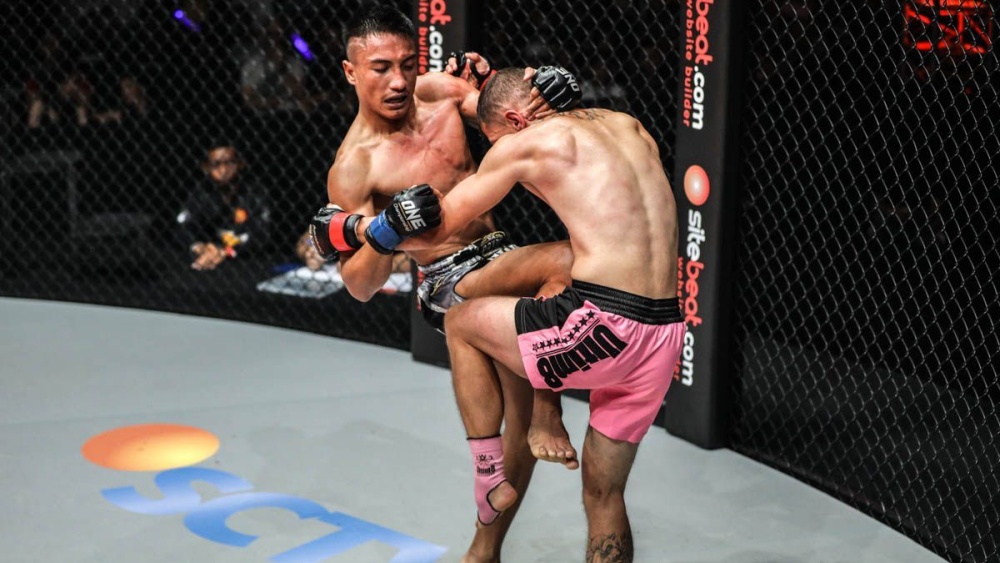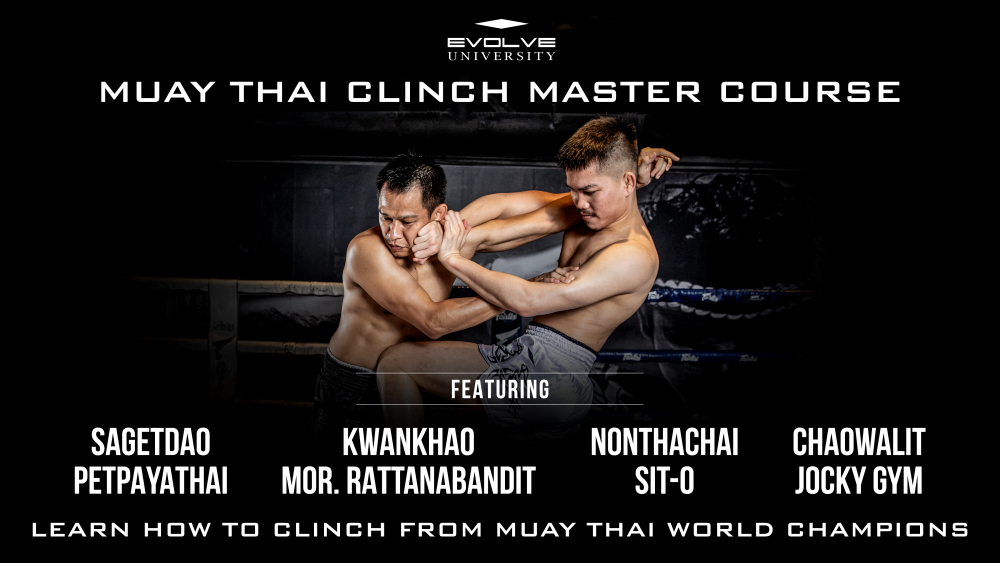The Muay Thai clinch is what separates the art of eight limbs from other striking disciplines.
In martial arts such as boxing and kickboxing, fighters grab their opponents for defense or a moment of respite, before they’re quickly separated.
There’s no opportunity for that kind of stalling for Muay Thai athletes. When they get up close and personal, they get busy with some of the sport’s most spectacular offenses.
Sweeps, dumps, knees, and elbows score big and can turn the tide in a fight in the blink of an eye.
But before a fighter starts to attack with these techniques, they have to know how to get into position and expose a gap in their opponent’s defense.
1. How To Enter The Clinch
No fighter with any acumen is going to let you march forward in a straight line and grab hold of them.
Just like any attack in Muay Thai, you need to take an intelligent approach that will ensure you can impose your offense without being hit back.
There are countless ways to enter the clinch, but these are some of the most straightforward.
1.1 Move forward and guard – A lot of clinch specialists put a lot of pressure on their opponents by walking forward and closing the distance.
However, even if your opponent is on the back foot, they’ll still be able to counter you with an elbow if you get in close. Therefore, the key to this approach is to keep a tight guard as you come forward.
As you advance, you can keep your rear hand clamped to the top of your head to defend against strikes from your opponent’s left arm.
At the same time, extend your lead hand forward to create a long guard and defend against strikes off your rival’s right arm. This hand will also be your first point of contact.
1.2 Hand fighting – This a great way to prevent your opponent’s offense and remove his defense at the same time.
If you can take control of their hand or arm, or even parry it, you can take it out of action. That will give you a big window to step in and strike, then take hold of their neck.
1.3 Slip and counter – Slipping punches and lateral movement will also give you a great opportunity to advance on your opponent unopposed.
Immediately after you’ve dodged than eir attack, step in to take control.
1.4 Punch into the clinch – You can also use your own strikes to make contact and gain the upper hand.
You can loop a left hook around the back of your opponent’s head as they cover up, and you’re in business.
1.5 Fakes and feints – Faking will also open a lot of doors to the clinch.
One example is the left hook, again. Instead of committing to a punch, a convincing feint can make your rival cover up, giving you the chance to close the distance with impunity.
2. Clinch Positions
Once you get inside and grab hold of your opponent, there are multiple ways to take control of the position and attack.
These are the most common.
2.1 Double collar-tie
If your knowledge of Muay Thai is rooted in MMA, you might think of this as the go-to clinch position.
It was made famous by the Silvas; Wanderlei and Anderson, who’d grab opponents by the back of the head with both hands and knee them into oblivion.
There’s no doubt that this is a dream position. The problem is, it’s far easier said than done in the art of eight limbs.
Nak muay will want to avoid this position at all costs, so you’d be lucky to spend much time there against any opponent who knows what they’re doing.
2.2 Single collar-tie/50-50 position
This is probably the most common clinch position in Muay Thai. Both fighters have control of their opponent’s opposing arm on one side, and a hold on their opponent’s neck with their other arm.
From there, fighters will start trying to swim their arms through to take a dominant position, while pushing and pulling to make room to strike.
2.3 Double underhooks/body lock
If you can get both of your arms under your opponent’s, you’ll take a dominant position that’s difficult for them to escape.
It’s not as easy to unleash striking offense from here compared to the plumb position, but you can use it to dump them or take the back.
2.4 Cross lock
You can still take a dominant position with just one underhook.
If you can get around to your opponent’s side, and apply pressure by driving your head into their chin and tightening your grip, you can isolate an arm and expose their midsection.
That gives you a great opportunity to throw knees to their defenseless torso or sweep them onto the mat.
2.5 Double overhooks
This position doesn’t look too strong, and it’s not that common to see in the heat of battle, but it is surprisingly effective.
Rather than holding your opponent tight by wrapping your arms over theirs, this clinch technique is achieved by using T-Rex arms to control the inside of their limbs.
You can use this grip to move your rival, open up space for knees, or even come over the top with elbows.
3. Clinch Essentials
Once you’re in position, you can start to knee, elbow, and sweep.
However, your opponent will not make it easy for you to do that. They’ll always be trying to improve their position, attack, or escape.
To make sure they don’t, keep the following principles in mind.
3.1 Adjust your stance
If you stay in your normal stance in the clinch, your front leg will be an easy target for knee strikes.
Instead, your hips should be square under your shoulders, and your knees slightly bent. This will allow you to maintain your position and give you a strong base to mount your own offense.
You can move your feet when you attack – to give yourself leverage to move your opponent or to set up a powerful knee.
3.2 Control the arms
A well-timed elbow could cause you to lose a fight in the blink of an eye, so you should stop them at all costs.
Overhooks, underhooks, pushing, and pulling will allow you to stop your rival from using their arm to arrack, and help you to take a dominant position.
3.3 Control posture
You will make your attacks more effective if you can break your opponent’s posture.
Move them off-balance, and it’ll be easier to find a window to strike. Pull them toward you and your strikes’ impact will be increased.
If you can grab the neck and break their posture completely, that means their head is in the perfect position to be kneed.
4. Don’t allow your opponent to do any of the above
Obviously. Anything that will give you an advantage will put you in peril if the tables are turned.
Make sure you stand strong, and you’ll be set for success.
Evolve University’s Muay Thai Clinch Master Course
Evolve University is excited to announce the release of the Muay Thai Clinch Master Course, an in-depth online video Master Course taught by legendary Muay Thai World Champions!
No detail is spared as Evolve MMA’s Muay Thai World Champions break down the fundamental aspects of the Muay Thai clinch. Structured and taught in a systemized way that will allow students to build their clinch game piece by piece, the Muay Thai Clinch Master Course is organized by position, covering the four main clinch positions — double inside, double outside, single collar neck tie, and double collar neck tie. Learn the vital details behind positional control, elbows, knees, sweeps, transitions, pulls, and defense in the clinch.
Whether you’re learning how to clinch for the first time and are looking to develop a strong foundation to build upon or are a seasoned practitioner with years of experience needing to refine your technique, fix bad habits, or add to your toolbox, this Master Course is for you.
Packed with over 8 hours of on-demand video content structured into 28 instructional chapters, Evolve University’s Muay Thai Clinch Master Course is the ultimate guide to learning the Muay Thai clinch.
Get Evolve University’s Muay Thai Clinch Master Course Today!












